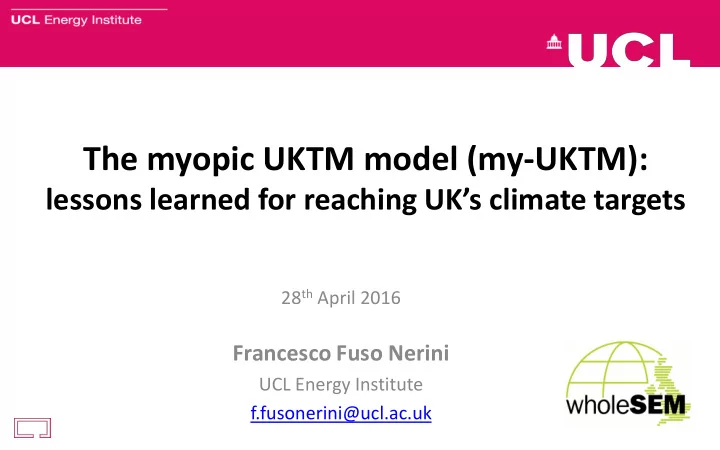

The myopic UKTM model (my-UKTM): lessons learned for reaching UK’s climate targets 28 th April 2016 Francesco Fuso Nerini UCL Energy Institute f.fusonerini@ucl.ac.uk
UK’s decarbonization goals Climate Change Act: 80% GHG reduction by 2050 ‘Carbon budgets’ strategy Four carbon budgets have been legislated, and the fifth is currently under review FIGURE 1 UK'S APPROVED AND UNDER REVIEW CARBON BUDGETS (Committee on Climate Change, 2015)
UKTM – The UK TIMES Model Continuously used for policy support Successor to UK MARKAL Overview Integrated energy systems model Prefect foresight Least cost optimization Partial equilibrium Technology rich
Rationale for Myopic models Optimization models useful for providing information regarding the cost- optimal pathway for reaching decarbonisation goals HOWEVER Governmental decisions are made with a limited decision horizon and imperfect knowledge of the long term developments of those decisions (Keppo and Strubegger, 2010). Models with a myopic foresight could be useful to better represent the shorter term focus of decision making compared to perfect foresight models.
Myopic UKTM (my-UKTM) Same technology detail as UKTM Myopic foresight Advantages: Comparable with UKTM can be used in conjunction Better represents myopic decision making Lower computational times FIGURE 2 EXPLORED FORESIGHT OPTIONS
Why Myopic UKTM With the carbon budgets the UK is setting a long-term vision However, changing circumstances (e.g. governments), uncertainty regarding the future and the high-capital requirements of energy projects result often the adoption of short-term measures and in the postponement of long-term strategic decisions Combining the usage of UKTM and my-UKTM can help understand: The linkage between short- and long- term goals The effect of possible path-dependencies and lock-ins in the energy sector How i nsights gained from a perfect foresight model (e.g. carbon prices) could work in world where decisions are made myopically
Scenario Analysis PERFECT FORESIGHT-UKTM • perfect foresight UKTM model for achieving 80% GHG reduction by 2050 MYOPIC-20 & MYOPIC-10: • As PF-UKTM but with 20 and 10 years foresight respectively FIGURE 1 UK'S APPROVED AND UNDER REVIEW CARBON BUDGETS (CCC, 2015) MYOPIC-20-CT & MYOPIC-10-CT: Marginal price • a carbon tax obtained from the PF-UKTM of CO2eq scenario is applied to the my-UKTM runs (20 and 10 years foresight)
The effects of myopic foresight Structurally different investments 30 Agriculture & Land Use Perfect foresight UKTM 20 Services Invests in long-term structural Electricity 10 investments from year 1 (e.g. [Mt CO2] Industry 0 electricity and hydrogen-based Residential transportation) Transport -10 Myopic UKTM Hydrogen -20 Processing Invests in projects with a short-term -30 Upstream view, with the result of having to invest in a range of technologies in the last model years FIGURE 3 DIFFERENCE IN GHG EMISSIONS, MYOPIC 20 – PERFECT FORESIGHT
The effects of myopic foresight FIGURE 4 CUMULATIVE COST DIFFERENCE BETWEEN PERFECT FORESIGHT AND MYOPIC UKTM RESULTS [BILLION £] 600 Lower costs in the first model 500 405 400 years 308 300 223 200 193 173 Considerably higher costs after 100 126 75 2025 28 0 8 0 0 1 -6 -10 -11 -36 -65 -68 -100 -200 2010 2015 2020 2025 2030 2035 2040 2045 2050 Myopic 20 Myopic 10
Effect of a carbon tax obtained from the perfect foresight model Carbon tax in my-UKTM as the FIGURE 5 TOTAL EMISSIONS APPLYING A CARBON TAX FROM THE marginal cost of GHG in perfect PERFECT FORESIGHT MODEL [Mt CO2eq] foresight UKTM: 700 600 2020 2030 2040 2050 500 CO 2eq price 400 [£/t CO2] 37 99 128 288 300 200 The myopic runs do not reach the 100 target of 80% GHG reduction by 2050 - 70% reduction for the myopic20 2010 2015 2020 2025 2030 2035 2040 2045 2050 65% reduction for the myopic10 Myopic 20 Myopic 10 Perfect foresight
Conclusion & way forward Perfect foresight and myopic UKTM can be used in conjunction to gain policy-relevant insights ‘Myopic’ planning results in the delayed adoption of low-carbon technologies and increased costs for reaching UK’s decarbonisation goals A carbon tax obtained from perfect-foresight optimization models may be under-valued Ongoing work to look at the effect of late action on the achievement of the decarbonisation goals
Thank you for your attention! Francesco Fuso Nerini UCL Energy Institute f.fusonerini@ucl.ac.uk
Recommend
More recommend